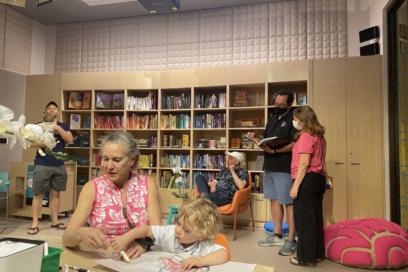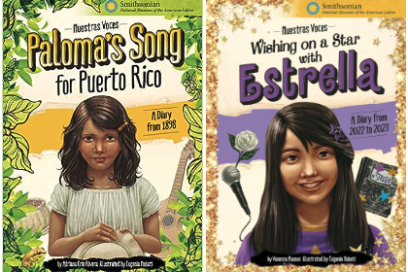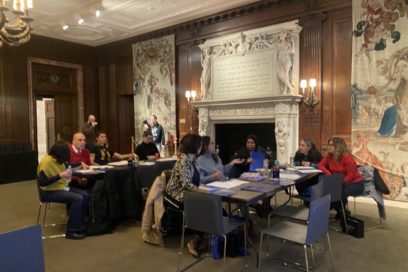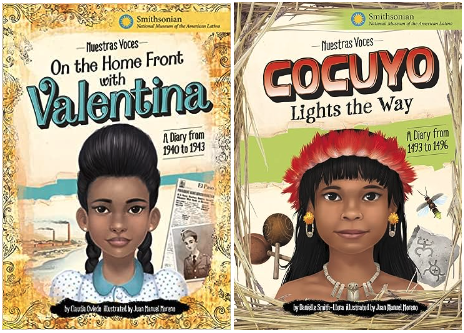How do you tell a complete American history? Whose stories are we missing? Where do you find these histories? If you have wondered about these questions, you are not alone.
I have spent most of my career learning untold stories and finding engaging ways to share and make them relevant for today’s young people. I remember as a child being fascinated with stories unfamiliar to me with PBS’ “Reading Rainbow” TV program. I would run to watch the program to learn about the new adventures I could go on in the pages of a book. Books would become a way to continue to learn long after I left the classroom. Today at the National Museum of the American Latino, I work daily to ensure untold stories of Latino achievement are elevated, celebrated and understood.
Starting a book collection
Over the past five years, our team has been working to weave these important stories and chapters of American history into mainstream publications. We were able to work with Running Press Kids to release our first publication, ”Nuestra América: 30 Inspiring Latinas/Latinos Who Have Shaped the United States.” This anthology tells the stories of notable Latino pioneers, artists, activists, military veterans, entrepreneurs and other figures. The publication was also made available in Spanish and features a bilingual puzzle and memory game as complements to student exploration of the people featured in the book. Our next set of books took a different approach.
Meet the “Nuestras Voces” diary series!
Have you heard of or remember the American Girl historical novel series for kids? Well, “Nuestras Voces” combines an American Girl and “Dear Diary …” approach with Smithsonian research and Latino objects in the national collection to tell chapters of US Latino History in American history.

Why children’s literature, and why girls? Children’s books allow us to tell complex stories in more easily relatable ways. Coming-of-age stories featuring young girls in a growing America give all students today opportunities to see themselves through these book characters, making the story all the more impactful. We believe that creating avenues for children to develop their own agency through reading transforms literacy from a corner of education to a key for change-making and lifelong learning. Through books, we can show the breadth of US Latino history and give insight to untold stories of Latinos in the creation and building of the country.
This allows us to engage young people, their families and even adults in reading and conversations that promote first-voice cultural storytelling. It also fosters opportunities for intergenerational dialogue and discussion on family history and their family’s own cultural legacies and traditions. As the philosophy of “Mirrors, Windows, and Sliding Glass Doors” by Rudine Sims Bishop, Ph.D., outlines, all good books allow us to see a mirror of our own story, and windows into others’ experiences, and sliding glass doors to enter new worlds. That is what “Nuestras Voces” does so seamlessly.
The young girls from “Nuestras Voces”
Cocuyo, Paloma, Valentina and Estrella are four young Latinas in different time periods in US history, all trying to understand what is happening in their community, how the historical events unfolding around them impact their family, and the development of their own cultural and personal identity.

Let’s look, for instance, at Valentina, from ”On the Home Front with Valentina,” who is an 11-year-old girl in 1940 El Paso, Texas. She takes us through her family’s story of faith, family and freedom during World War II. She gives the reader insight into her family dynamics and how they are affected by her brothers enlisting in the military and becoming part of the all-Mexican American battalion Company E. She handles all this while also coming of age and dealing with normal growing-up rites of passage by writing about her day-to-day life in her diary that we are able to read alongside her.
We can go back in time and meet Cocuyo and her dog, Xingu, a young Taína girl in Quisqueya (modern-day Dominican Republic and Haiti) as she and her community deal with the first encounter with Europeans and endure Spanish colonization. In ”Cocuyo Lights the Way,” we learn about key moments in colonization and the everyday cultural traditions of the Taíno, the Indigenous ancestors of many Dominican Americans and Puerto Ricans today.

Through ”Paloma’s Song,” we learn about the island of Puerto Rico at the turn of the 20th century. We find out about life on the island, its economy and society from Paloma’s farmer family. Paloma then takes us with her through the tumultuous time of the 1898 Spanish-American War and the arrival of the Americans on the island. Through Paloma, we also learn about how becoming a US territory allowed Puerto Ricans to migrate to the US mainland and join the military in search of work and opportunity.
Finally, in ”Wishing on a Star with Estrella,” or *Strella as she spells it, we meet a contemporary young girl trying to figure out her place in the world, coming to terms with who she is and her own heritage and cultural background. This is all while learning about the woman she is named after, Selena, the Tejano singer who broke barriers in Spanish and English language music in the early 1990s.
These four young girls help readers understand the often complex realities of the history of our communities and country we call home. We are taken through different time periods, challenges and opportunities, and regions of the US and sometimes the world, all the while keeping us grounded in the historical facts and how these challenging situations affect how young people – and this lets young girls see themselves in the world.
The “Nuestras Voces” book series is accompanied by a reading guide and glossary within the book and a free digital resource via the National Museum of the American Latino’s page on the Smithsonian Learning Lab. The Smithsonian Learning Lab for “Nuestras Voces” includes four different collections, one for each book, with the digitized versions of the Latino objects that inspired the stories, additional resources for educators, as well as museum object-based activities and discussion prompts for easy use in the classroom.

Educator feedback on the series
We recently conducted an educator engagement workshop in New York City on using these books and museum objects to introduce new stories in social studies, visual arts, language arts or English for speakers of other languages classrooms. What we discovered is that teachers are excited to use children’s books, museum objects and activities to enhance their classroom curriculum.
From our Educator Engagement Series, we have refined the following five core ideas with teacher feedback.
1. Educators are inspired by these stories and museum-based activities to use new approaches in the classroom.
“I love the idea of students journaling beforehand and afterward — I really feel like this will be game-changing for them and for me.”
“I am going to go back to my classroom and use the object biography activity to understand primary sources!!!!”
2. Primary and secondary source texts and objects allow history to come alive.
“How to connect museum materials to different types of learners.”
“It allows us to dig deeper and become more inquisitive.”
3. Children’s books help tell more complete stories beyond the textbook.
“The series of books reflect young girls that allow us to see their possible perspective. Our young students could relate to them more deeply rather than having us teachers preach to them.”
“It gives an individual, more personal point of view of various subjects, giving them more meaning to the reader.”
“It makes them able to connect their lives to the lives of the characters and to understand that world history is built by human stories.”
4. It’s all about making connections and being curious to learn.
“They bring an opportunity to be curious and think about history as a lived experience.”
“Connecting families to what happens in the classroom begins with validating others’ experiences. Showcasing what families contribute makes students aware that we are all partners in learning.”
5. The importance of storytelling and narratives in our daily lives.
“Our brains are programmed to remember and understand through stories — they are key!!”
Join us in exploring new and untold stories that help us understand how our communities come together and continue to build America. Latino history is American history. Learn more about the museum, our educational resources and our free programs in the Washington, D.C., area and across the country at www.latino.si.edu.
Opinions expressed by SmartBrief contributors are their own.
_________________________
Subscribe to SmartBrief’s FREE email newsletters on social studies and civics to see the latest hot topics in education. They’re among SmartBrief’s more than 250 industry-focused newsletters.
